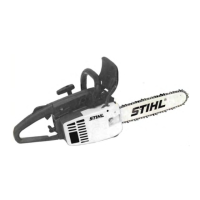Cutting Attachment
Guide bar with oil inlet and locating holes
The cutting attachment of a chain saw consists of the guide
bar,
saw chain and chain sprocket.
Guide bar
The nose and underside of the guide bar are subjected to
particular high stress and strain.
To
avoid one-sided wear,
turn the
gUide
bar over every time you resharpen or replace
the chain. Regular cleaning of the oil inlet holes and the
guide bar groove
is
also very important.
The guide bar can be examined for signs of wear
at
the
same time. A minimum groove depth of 5
mm
(0.2 in)
must
be
maintained in order to avoid the drive link tangs
scraping the bottom of the groove·(the cutters and tie
straps would not be able to run
on the guide bar rails).
This depth should
be
measured
at
the spot where the bar
is
stressed most,
i.
e.
the bar nose
on
Duromatic bars and
the area with which most cutting
is
done
on
Rollomatic
bars.
The guide bar must
be
replaced if the minimum depth
26 cannot
be
maintained.
To
lubricate the Rollomatic guide bar, place chain saw
on
its side so that the bar nose
is
firmly supported. Clean the
grease hole and pump
in
greasewhile slowly pulling saw
chain around bar (sprocket rotates)
so
that bearing
is
uniformly filled. When grease emerges
at
the hole
on
the
other side of the bar or around the nose sprocket, repeat
the procedure on the other side.
Chain lubrication
Never operate the chain saw without proper chain lubri-
cation. Check operation of chain lubrication and level
in
oil
tank before starting work.
Hold chain saw with mounted cutting attachment over a
light background. Take care, the Oilomatic chain must not
touch the ground,
i.
e.
keep
it
at
least 20
cm
(8
in)
clear of
the ground.
Run
the engine with half-throttle position.
If
an
increasing patch of oil can
be
seen, chain lubrication
is
operating correctly.

